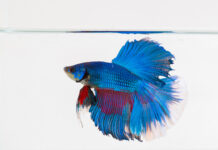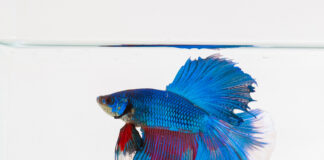Algae is responsible for over half of the oxygen in our atmosphere. Thatâs right, a lot of the air we breathe comes from the biological processes of algae.
Additionally, their diversity and distribution play a significant role in many natural ecosystems. Undoubtedly, these organisms are vital for life, especially for aquatic inhabitants. However, in the unnatural enclosed ecosystem of an aquarium, algae growth isnât always a good thing.
Although some level of growth is essential to the biological processes of the fish tank, unimpeded algae growth may pose a grave risk to your aquarium inhabitants. This potential hazard is why many aquarium hobbyists make use of algae eaters hence checking overall algae growth.
Hence, looking into what eats algae and how this can greatly benefit your aquarium will be critical for any aquarist.
In this article, weâll take a brief look at algae and several the helpful algivores that will keep algae in check!
More…
Into Algae

Algae share many similar traits with plants. For example, both plants and algae process light for food via through photosynthesis while also sharing the familiar green color. Also, they are both sources of diet and oxygen as well as shelter for fish and other animals. However, despite these similarities, algae possesses many other characteristics that distinguish them from plants.
The term âalgaeâ refers to organisms that come in numerous forms, sizes, and kinds. In fact, algae may exist as single microscopic cells or those that are multicellular. Other types of algae live in colonies while some others, like kelp, resemble foliage. Some simpler organisms that include types of bacteria, such as prokaryotes, are also included under the algae family.
To the aquarist though, they notice algae most commonly as green, or brown films, spots, and hair-like growth in their aquariums. This development is, of course, natural especially after you successfully cycle a tank. In any case, if your tank suffers algae woes, it would be wise to determine the type of algae that is causing the problem.
Enter the Algivores

Usually, algae grow and reproduce quickly, needing only sunlight, carbon dioxide, and some other nutrients to thrive. Hence, you shouldnât be surprised when you notice the algal bloom in your aquarium.
However, this growth also means they can quickly take over your aquarium water and your tank. Afterward, algae overgrowth may lead to risky water parameters which will then endanger the life in your tank. Here is where algivores become quite important to the aquarist.
Algivores are essential organisms that feed on the different types of algae. In healthy ecosystems, you would typically find algivores such zooplanktons and aquatic insects depending on a steady diet of algae.
However, the presence of these tiny animals may not be enough to keep the growth of algae in check. Therefore, many aquarists would add aquatic inhabitants that have a bigger appetite for algae.
Popular algivores include shrimp, snails, bivalves, and several types of fish. This article will list down some of the best algae eaters that you can add to your aquarium as well as the ones of which you should be wary.
The Best Algae Eaters
Numerous aquarium pets feed on algae, but only a few are highly effective at controlling growth. Weâve listed below the best and most efficient algae eaters that you can add to your tank.
You may even want to get more than one algivore if your aquarium is slowly yet noticeably turning green or cloudy due to algae.
Invertebrates

Crustaceans, mollusks, and bivalves primarily feed on algae. So, besides trying to reproduce, their primary purpose in life is to find and eat algae. This affinity to the algal organisms in your tank is the reason why invertebrates are among the favorite algivores for aquarium hobbyists.
- Shrimp
Shrimps are probably one of the most popular algae eaters around and for a good reason. These voracious eaters love the majority of algae that grow in tanks. Theyâll even eat detritus and otherwise uneaten food too, so shrimp are also popular as tank cleaners.
A favorite algae-eating crustacean is the Amano shrimp with its greenish color streaked with red. Growing to a size of an inch to 5 inches, Amano shrimp will quickly reach algae in the nooks and crannies of your tank. Usually, youâll see them actively moving about the aquarium grazing surfaces and substrate for algae
Another famous shrimp species is the Wood Shrimp. In addition to their steady diet fuzz or thread algae, wood shrimp is especially popular for keeping blue-green algae, which many other algivores tend to ignore. You can rely on shrimp to take care of hair or filamentous algae. However, if free-floating algae or green spot algae is causing your tank woes, then you may want to consider other algivores.
Other algae-eating shrimp:
- Dwarf shrimp
- âGhost shrimp
- âCherry shrimp
- Snails
Our mollusk friends were one of the very first algivores that aquarists utilized to keep algae at bay. Although not as efficient as shrimp or some fish, snails will feed on a steady diet of algae that they will find on plants, rocks, aquarium walls, and aquarium décor.
A good example of an algae-eating snail is the Ramshorn snail. True to its name, the Ramshorn snail resembles its namesake endearing them to many hobbyists. These little critters will reach sizes around 3/4-inch and will eat up algae like little vacuum cleaners.

Another favorite algae-eating mollusk is the Nerite snail. Like the Wood shrimp, the Nerite snail is much-loved for their specific diet choices. So if your aquarium is suffering the loathly green spot algae, a type of algae that shrimp ignore, then a
Nerite snail should be your algivore of choice! These mollusks will seek out green spot algae, as well as many fuzz or beard algae.
A word of caution, though, when you decide to use snails. These mollusks reproduce very quickly, and some may even chomp on your aquarium plants if algae are not readily available!
Other algae-eating snails:
- Malaysian Trumpet snail
- âMystery snail
- Sun snail
- Freshwater Clams
Bivalves can also be useful algae-eaters. In fact, many hobbyists specifically purchase clams to take care of a particular algae problem: green water.
So, although you canât rely on clams to move around and take care of algal films or filamentous algae, their filter-feeding habits will address plankton-sized green algae that turn aquarium water a cloudy green color.
Whether its clams or even mussels, adding a bivalve or two to a tank suffering green water will be a very good idea!
Fish

Fish eat algae. However, common fish are lightweights compared to the algae-eating fish on our list.
- Twig Catfish
The Twig Catfishâs long sucker mouth tells you one of its favorite food is algae. Usually, youâll see this algae-loving fish feeding along the bottom of aquariums. In fact, twig catfish or Farlowella catfish love algae so much that youâll need to supplement their diet with algae feeds if they inhabit markedly clean tanks lacking sufficient algal growth.
- Bristlenose Plecos

Plecos are most likely the most popular algivores in our fish categories, and it’s surely not because of their looks. However, what plecos lack in looks, they sure make up for in their ravenous appetite for algae and other green foods. image
Similar to the twig catfish, plecos will need vegetable supplements to their diet if there is a lack of algae in the tank. Otherwise, they will end up munching on your precious aquarium plants as well.
- Siamese Algae-eater (SAE)

If you seek a more ânormalâ looking fish that has a propensity to hunting down algae, then you should consider getting a Siamese Algae-eater. In addition to their enormous appetite for many types of algae, this fish will also scavenge uneaten food as well as those pesky flatworms.
Being robust swimmers and jumpers, ensure that you seal your tank as these little critters can easily jump out of the aquarium.
Beware the False Algae Eater
The Chinese Algae Eater (CAE) is all too common in pet stores and is one of the most popularly-sold algivore. Despite its name, the Chinese Algae Eater isnât very efficient when it comes to controlling algae. In fact, the name âChinese Algae Eaterâ is a bit of a misnomer.
First of all, you can find this fish all over Asia. Second, CAE feeds on algal films primarily during infancy. However, when they mature, the CAE become quite aggressive and have the tendency to feed on the body of other fish.
This mode of feeding will be detrimental to the life of your other fish and may even kill them! Hence, it is not at all uncommon for aquarists to suddenly find their aquariums devoid of any other life except the CAE.
Conclusion
A balanced amount of algae in your tank will contribute to the health and even authenticity of your aquarium. They are also vital for the life of your fish or invertebrates. Hence, you can always keep algae from overgrowing with our list of the most efficient algae eaters!
>>> Read More:
Related Posts:







